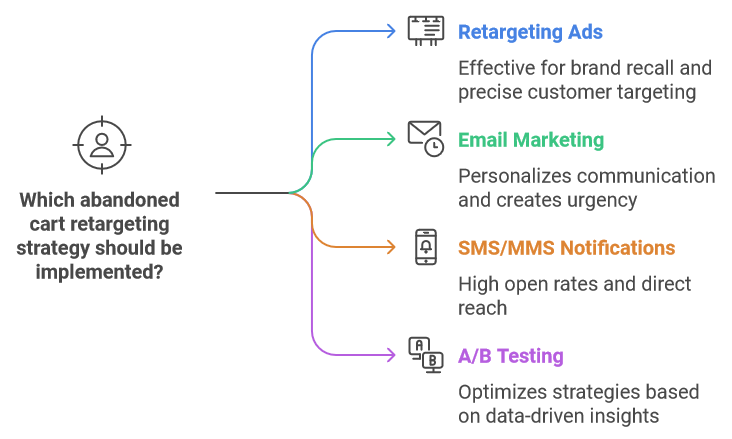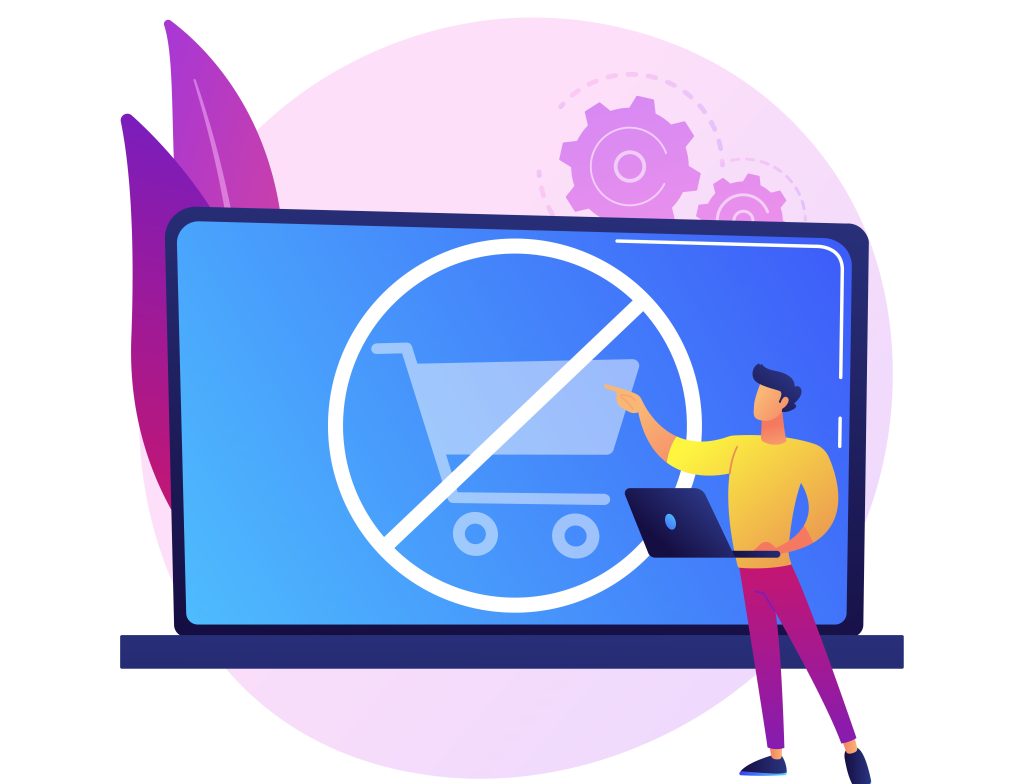Digital consumers can fill their shopping carts all the way to your ecommerce checkout page and end up not making the purchase.
Cart abandonment sure is frustrating, but this is a common occurrence and a challenge most if not all online retailers face. And that’s where the art and science of cart abandoner retargeting comes into play.
In this guide, we lift the curtain on the top reasons behind shopping cart abandonment, prevention, and strategic solutions to win them back and increase your conversion rates.



| Reason | Percentage | Strategic Approach |
|---|---|---|
| Extra Costs (Shipping/Tax) | 48% | Offer transparent pricing, free shipping options |
| Mandatory Account Creation | 26% | Provide guest checkout, simplified registration |
| Payment Security Concerns | 25% | Highlight secure payment gateways, trust badges |
| Slow Delivery Speed | 23% | Communicate fast shipping, provide delivery estimates |
| Complex Checkout Process | 22% | Streamline checkout, reduce steps, improve UX |
| Unclear Total Order Cost | 21% | Display complete pricing upfront, cost calculator |
| Unsatisfactory Returns Policy | 18% | Offer flexible, clear return guidelines |
| Limited Payment Methods | 13% | Integrate multiple payment options |
| Credit Card Declined | 9% | Provide payment troubleshooting, alternative methods |
It’s a real mood killer when shoppers find the perfect item only to see the price shoot up at checkout.
Think: shipping costs, taxes, or other unexpected charges. As a result, online shoppers leave their carts behind and find a better deal elsewhere.
Just because they made it to the latter stage of the sales funnel doesn’t mean they’re in fact in a buying mode. A lot of people browse through online stores just to window shop.
They may still be under the process of comparing prices, saving items, checking for possible discounts, or simply exploring what’s out there.
When faced with too many steps, endless forms to fill out, or confusing navigation structure, it’s a major turn-off for your online shoppers. And a surefire way to ditch their carts.
Some people have preferred methods of payment. Whether it’s PayPal, a specific credit card, or another digital wallet. They might just leave their carts if their payment preference isn’t in the options. As simple as that.
Consider offering a variety of payment options for convenience and security among your potential customers. Accommodating different payment preferences will doubtless help complete the sale.
Requiring shoppers to create an account before they can complete a purchase? Another common reason for abandoned shopping carts.
Sure, account features like order tracking and personalised recommendations are great. But many customers find it an unnecessary hassle especially if they’re in a hurry or making a one-time purchase.
Digital consumers are smart and savvy. Not to mention increasingly wary of site security red flags. If your e-commerce website doesn’t look trustworthy, customers may hesitate to enter their payment details and abandon their carts.

Reminding shoppers about their ‘unfinished business’ on the checkout page, and by extension prompting them to make a purchase, can be achieved through the following:
One of the most ideal ways to re-engage with cart abandoners is running remarketing ads.
You can run it through Google search or social media platforms such as Facebook and Instagram.
Reasons Why they Work:
Dynamic retargeting, or showing previously-checked products to your basket abandoners, is a personalised approach to give them that extra nudge to finalise a purchasing decision.
By displaying an ad of the exact item in their cart, you’re reminding them of their abandoned baskets.
It’s a psychological tactic that jogs their memory and reignites interest in the product they discovered through your site.
If they provided their email address prior to leaving, it’s wise to run a cart abandonment email campaign for re-engagement.
Personalisation is a key sales driver here.
Aside from simply mentioning the user’s first name both in the subject line and in the opening email, show them recommended items that they’d be interested to check out.
Utilise the scarcity principle by displaying limited-edition products to appeal to your customer’s fear of missing out. This cart email best practice creates a sense of urgency.
Now timing is an equally essential aspect of your warm email retargeting strategy.
How to do it?
Schedule three emails to send to your cart deserters as follows:
Email #1: send your very first email within 30 minutes to an hour after the basket abandonment happened. Customers may have already bought a similar product if you wait for hours to days before sending it.
Let’s give you an example:
Subject line: Hey John, Your Items Are Waiting for You!
Hi John,
We noticed you left a few items in your cart. We just wanted to make sure you didn’t miss out on them! Your selected products are still waiting for you and won’t be here forever.
To make things easier, simply click the button below to complete your purchase:
[Complete My Purchase]
If you have any questions or need assistance, we’re here to help! 🙌
Best regards,
…
If they didn’t respond or act upon your 1st email, send your 2nd follow-up email after 24 hours. Then the 3rd and final email after 72 hours.
This is a more balanced approach. Since you don’t want your warm prospect to experience retargeting fatigue.
At the same time, you don’t want to miss out on the opportunity of possibly winning over a customer who will convert. Persistence is key here.
According to a report, sending branded text messages has a whopping 98% open rate. And 45% of those actually respond.
Ecommerce businesses should highly consider SMS marketing to directly reach and retarget lost customers who didn’t initially convert.
To diversify your abandoned cart recovery strategies, running an MMS campaign, while a bit more expensive, can likewise help better advertise and showcase your brand through visual media.
Meanwhile, push notifications have a low open rate at a measly 4%. But only because recipients can already see them, being reminded of their pending purchases without having to click on the notification.
If a customer ended up completing a purchase a day or two after receiving a push notif, it’s not unlikely that it was at least partly influenced by it.
Which of your strategies for abandoned cart recovery are actually working, and which one needs more improving?
Take advantage of AI and automation tools to track and optimise your retargeting campaigns. Check your performance stats and make data-driven decisions to maximise your results and impact.
Key elements to A/B test include:
Ad copy: Test different headlines and descriptions to see which messaging resonates best.
Call-to-action: Experiment with various CTAs to determine which prompts more clicks.
Visuals: Compare images, videos, and graphics to find the most engaging visual content.
Ad format: Try different formats like carousel, single image, and video ads to see which performs better.
Special offers: Consider varying offers to identify the most effective incentive (i.e., free shipping, utilising discount codes).
Ad placement: Evaluate performance across different platforms (e.g., Google, Facebook, Instagram) and ad placements (e.g., feed, stories).
Timing: Experiment with different times of day or days of the week to find the optimal ad schedule.
Frequency capping: Adjust the frequency of ad displays to balance exposure and avoid ad fatigue.

There are plenty of strategies you can use to prevent lost sales and reduce shopping cart abandonment rate. It all boils down to the following.
Need a professional digital advertising marketer to run your retargeting campaigns?
Domain Bird is a Google-Partner certified PPC agency with a proven track record of delivering profitable client results.
For more information about what we can do and how we do it with a tailored approach for every business, book a consultation for a FREE campaign audit.
Get in touch with one of our dedicated marketing experts today!
Working with a trusted full service digital marketing agency Australia has to give can help you hit your two main targets: getting your business found online and increasing your profitability.
Get in touch with us. We’ll tell you how it’s done.